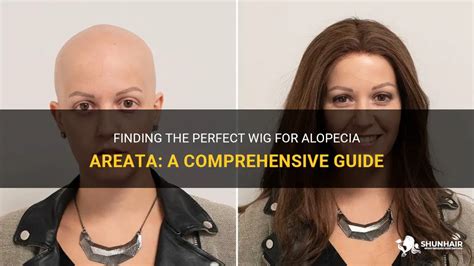Introduction
Alopecia is a condition characterized by hair loss, affecting millions of people worldwide. For those experiencing alopecia, wigs can provide a discreet and versatile solution to conceal hair loss and enhance self-confidence. This article offers a comprehensive guide to wigs for alopecia, exploring different types, materials, styles, and considerations to help you make an informed decision.

Types of Wigs for Alopecia
1. Natural Hair Wigs
Crafted from human hair, these wigs provide a natural-looking, high-quality appearance. They can be customized in terms of color, texture, and length, allowing for a tailored fit.
2. Synthetic Hair Wigs
Made from synthetic fibers, these wigs are more affordable and durable than natural hair wigs. They come in a wide variety of colors and styles, making them suitable for various tastes.
Materials for Wigs
1. Monofilament Wigs
These wigs feature a thin, breathable base that creates the illusion of a natural scalp. They are comfortable to wear for extended periods and allow for good air circulation.
2. Lace Front Wigs
Lace front wigs have a sheer lace panel along the hairline, which blends seamlessly with the wearer’s skin tone. This provides a realistic appearance and allows for styling versatility.
3. Full Cap Wigs
Full cap wigs cover the entire head, including the crown and nape of the neck. They offer the most secure and versatile fit, but may be warmer to wear than other wig types.
Wig Styles for Alopecia
1. Short Wigs
Short wigs are ideal for those who prefer a low-maintenance look. They can be styled in various ways, from pixie cuts to bobs.
2. Medium-Length Wigs
Medium-length wigs offer more styling options, such as layers, curls, and waves. They are suitable for various face shapes and can provide a natural-looking appearance.
3. Long Wigs
Long wigs provide maximum volume and versatility. They can be worn straight, wavy, or curled to create different looks.
Considerations for Choosing a Wig for Alopecia
1. Head Size and Shape
Measure your head circumference and shape to ensure a secure and comfortable fit.
2. Skin Tone
Choose a lace front wig that matches your skin tone to create a realistic hairline.
3. Comfort
Consider the weight, breathability, and construction of the wig to ensure it is comfortable to wear for extended periods.
4. Lifestyle
Select a wig that suits your lifestyle and needs. If you have an active lifestyle, consider a durable and low-maintenance wig.
Benefits of Wigs for Alopecia
1. Increased Self-Confidence
Wigs can help individuals with alopecia regain their self-confidence and feel more comfortable in social situations.
2. Privacy
Wigs can provide privacy and discretion for those who do not wish to disclose their hair loss.
3. Versatility
Wigs offer a wide range of styles and colors, allowing you to experiment with different looks and find the one that best suits your personality.
4. Protection from Elements
Wigs can protect the scalp from sun, wind, and other elements, which can be beneficial for individuals with sensitive or damaged skin.
Costs of Wigs for Alopecia
The cost of wigs for alopecia varies depending on the type, material, and style.
- Natural hair wigs can cost anywhere from $2,000 to $6,000 or more.
- Synthetic hair wigs typically cost between $200 and $500.
How to Care for Wigs for Alopecia
1. Cleaning
Wash your wig regularly with a mild shampoo and conditioner. Be gentle and avoid harsh rubbing.
2. Styling
Use heat protectant spray and style your wig using heated tools on a low setting. Avoid over-styling to prevent damage.
3. Storage
Store your wig on a wig stand or in a wig box when not in use. This will help maintain its shape and prevent tangles.
Conclusion
Wigs can empower individuals with alopecia to manage their hair loss and live confidently. By understanding the different types, materials, and styles of wigs available, you can make an informed decision that meets your individual needs. Remember to prioritize comfort, style, and quality when selecting a wig. With proper care, wigs for alopecia can provide both aesthetic and emotional benefits, allowing you to embrace your unique beauty.
Additional Questions to Consider
- What is the difference between a lace front wig and a full cap wig?
- How often should I wash my wig?
- How long does a wig typically last?
- Are there any special considerations for caring for wigs with synthetic hair?
- What resources are available to help me find the right wig for my needs?
